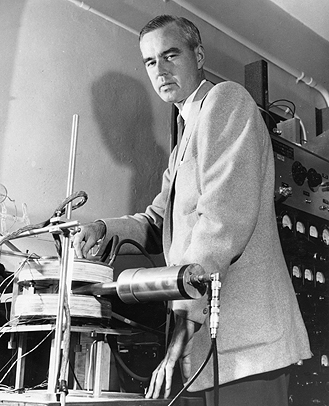One of the very best books I ran across in the process of doing research for Eureka is The Second Creation: Makers of the Revolution in Twentieth-Century Physics by Robert P. Crease and Charles C. Mann. It’s an extremely detailed treatment of the development of quantum theory, and includes anecdotes that I haven’t seen elsewhere. It also does a fantastic job of showing the essential interplay of experiment and theory through the difficult process of developing quantum field theory, which is often underplayed in popular treatments (which tend to be written by theorists, and often treat experiments as a sort of afterthought). Anyway, I got so much good stuff from Crease and Mann that I can’t let this series go by without using at least one of the new things I learned from their book for the first time.
One of the critical discoveries along the path to QED was what is now known as the “Lamb shift.” Its announcement at the famous Shelter Island conference kick-started the work of both Richard Feynman and Julian Schwinger, and when news of the Lamb shift reached Japan via the popular press, it did the same for Sin-Itiro Tomonaga, who would later share the Nobel with Feynman and Schwinger for developing the theory.
The curious thing about this is that Lamb is mostly known as a theoretical physicist. But the Lamb shift was an experimental discovery, so it couldn’t be named after him because of a prediction of the shift (which was mostly explained by Hans Bethe on the train home from Shelter Island, and the last piece was nailed by the development of QED). So, how did Lamb get his name on this? It turns out to be a by-product of physicists hazing each other.
Lamb was a student of Robert Oppenheimer’s, but didn’t particularly get along with Oppenheimer (according to Crease and Mann). He wasn’t in the first round of scientists invited to join the Manhattan projects for security reasons, but as the effort expanded, Oppenheimer called him in 1943 and asked him to join. Lamb declined the opportunity to work on the bomb, but did join up with the effort at Columbia University to improve radar systems.
The radar project was headed by the great experimental physicist I. I. Rabi, a colorful character in his own right. When Cold War paranoia led to hearings on whether Oppenheimer himself was a security risk, Rabi’s testimony included the line “We have an A-bomb and a whole series of it, and what more do you want, mermaids?” He was a great physicist, an outstanding scientific administrator, and didn’t have much patience for fools.
Anyway, Lamb joined Rabi’s project to make better radar sources, the microwaves for which were generated by magnetrons. Lamb’s primary job was to do calculations about how to improve these, but before he could do that, he had to do pass a test. Crease and Mann quote Rabi saying “We had a rule there that everyone who worked there had to make a magnetron. So that’s how Lamb got introduced to experimental work.”
Making a magnetron helped Lamb realize the potential of the war-driven improvements in microwave technology. Which, in turn, led to the realization that microwave spectroscopy offered a possible way of measuring the energy between the two lowest levels in hydrogen atoms– the first excited state of hydrogen has an exceedingly long lifetime, so you can’t just wait for atoms to decay. But if you prepare a bunch of atoms in that state, you can use microwaves to drive them to another nearby state that decays very quickly, and the energy difference between the emitted photon and the microwaves lets you figure out the energy of the lowest excited state. This was, at the time, a source of argument, as some experiments in the 1930’s had claimed to see a splitting of the two lowest excited states, something that both theory and other experiments claimed shouldn’t be there.
Lamb realized that the magnetrons being built for use in radar had nearly the right frequency to drive the transition in question, and were sufficiently high quality to settle the question once and for all. So, after the war, he recruited a grad student at Columbia, Robert Retherford, to help him do the experiment. And when they finally got results, the microwave frequency they needed had the “wrong” value, by about 10%. This indicated that the splitting suggested by earlier experiments was real, and would demand new physics to explain it. Lamb was so excited by this that he returned to the lab after Retherford had gone home for the night, to make sure he could reproduce the result. According to Crease and Mann, he ended up recruiting his wife as an assistant when it turned out he couldn’t do everything by himself. Happily, the result turned out to be very robust, and physics was never the same after that.
So, Lamb’s story is another reminder of the great things that can come out of stepping a little out of your comfort zone. (And can maybe also be cast as an example of the importance of phenomenology, as in Friday’s post…) One of the greatest revolutions in theoretical physics can be traced in part to the time when a new theorist was forced to act like an experimentalist to gain entry into a wartime radar project.
————
(Part of a series promoting Eureka: Discovering Your Inner Scientist, available from Amazon, Barnes and Noble, IndieBound, Powell’s, and anywhere else books are sold.)
(Image of Lamb in a lab taken from this AIP history page.)
(For a more detailed but non-mathematical description of what the Lamb shift is, I highly recommend this blog post.)

1 comment
Comments are closed.